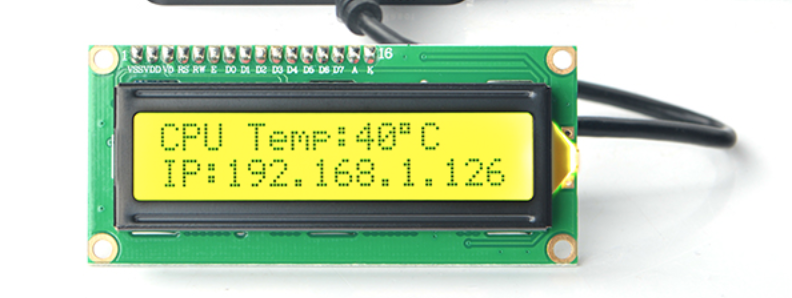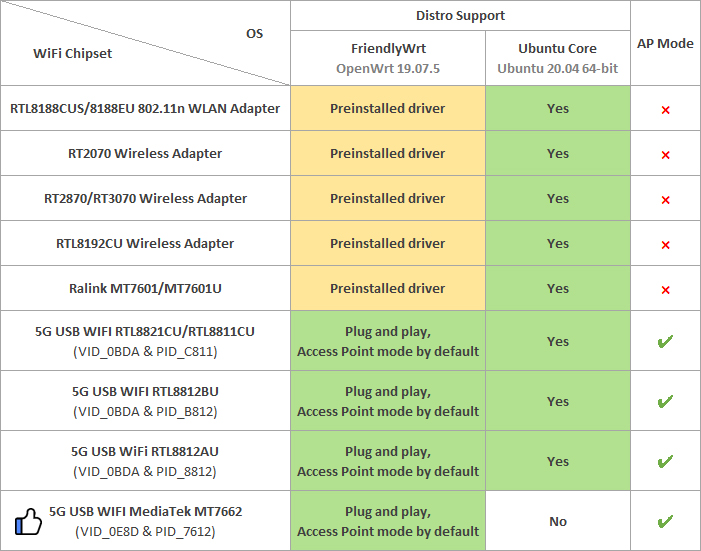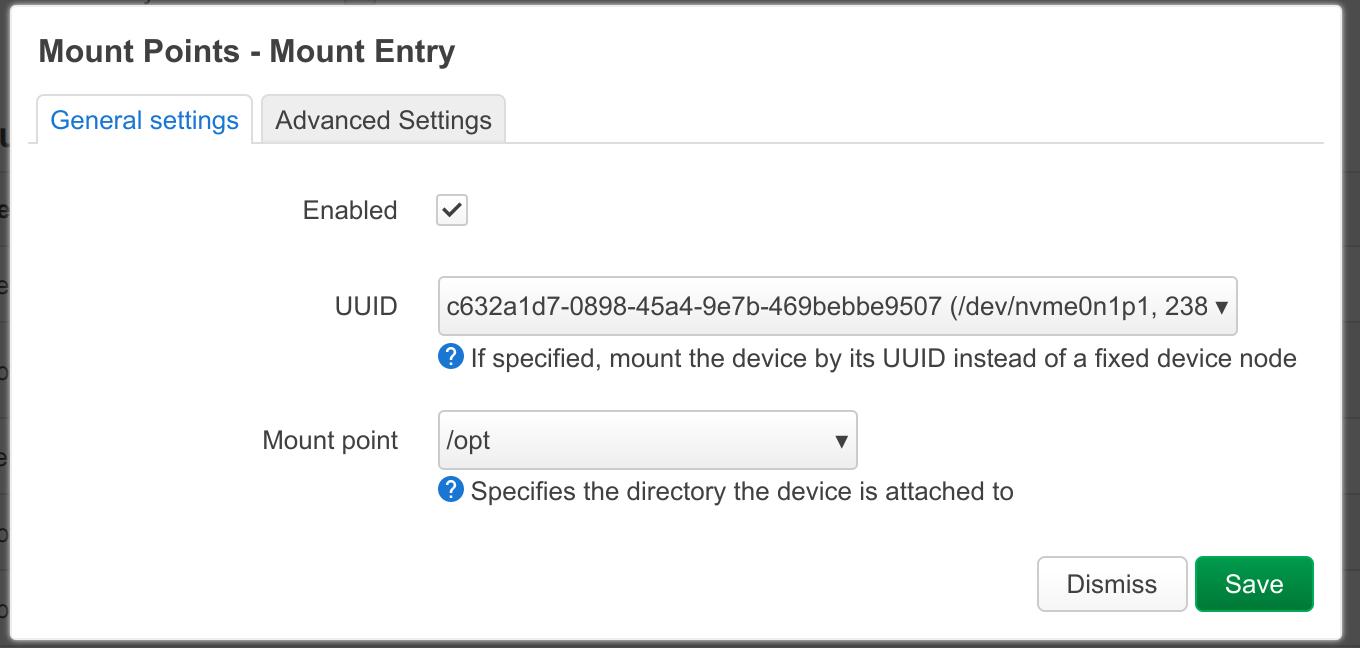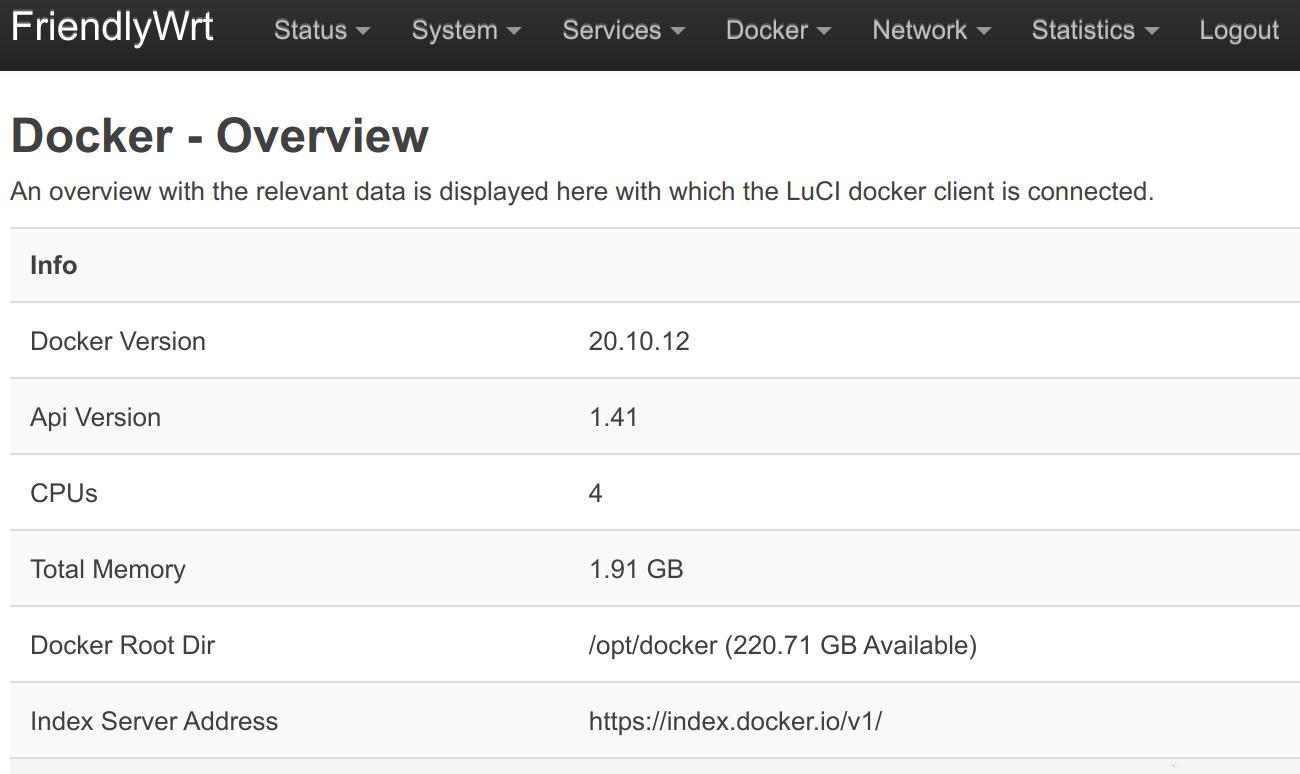Template:FriendlyWrt21
Contents
- 1 Work with FriendlyWrt
- 1.1 Introduction to FriendlyWrt
- 1.2 First boot
- 1.3 Account & Password
- 1.4 Login FriendlyWrt
- 1.5 Recommended security settings
- 1.6 Change LAN IP in LuCI
- 1.7 Safe shutdown operation
- 1.8 Soft Factory Reset
- 1.9 Install Software Packages
- 1.10 Disable IPv6
- 1.11 Configure the function of the user button
- 1.12 Configuring Quectel EC20 (4G module) dial-up networking
- 1.13 Some common issues of FriendlyWrt
- 1.14 Use USB2LCD to view IP and temperature
- 1.15 How to use USB WiFi
- 1.16 Work with Docker Applications
- 1.17 Mount smbfs
- 1.18 Use sdk to compile the package
- 1.19 Build FriendlyWrt using GitHub Actions
1 Work with FriendlyWrt
1.1 Introduction to FriendlyWrt
FriendlyWrt is a customized system made by FriendlyElec based on an OpenWrt distribution. It is open source and well suitable for developing IoT applications, NAS applications etc.
1.2 First boot
For the first boot, the system needs to do the following initialization work:
1)Extended root file system
2)Initial setup(will execute /root/setup.sh)
So you need to wait for a while (about 2~3 minutes) to boot up for the first time, and then set FriendlyWrt, you can enter the ttyd terminal on the openwrt webpage, when the prompt is displayed as root@FriendlyWrt, it means the system has been initialized.
root@FriendlyWrt
1.3 Account & Password
The default password is password (empty password in some versions). Please set or change a safer password for web login and ssh login. It is recommended to complete this setting before connecting {{{1}}} to the Internet.
1.4 Login FriendlyWrt
Connect the PC to the LAN port of {{{1}}}. If your PC without a built-in ethernet port, connect the LAN port of the wireless AP to the LAN port of {{{1}}}, and then connect your PC to the wireless AP via WiFi , Enter the following URL on your PC's browser to access the admin page:
- http://friendlywrt/
- http://192.168.2.1/
- http://[fd00:ab:cd::1]
The above is the LAN port address of {{{1}}}. The IP address of the WAN port will be dynamically obtained from your main router through DHCP.
1.5 Recommended security settings
The following settings are highly recommended to complete before connecting {{{1}}} to the Internet。
- Set a secure password
- Only allow access to ssh from lan, change the port
- Check the firewall settings
Set up as you wish.
1.6 Change LAN IP in LuCI
1) Click on Network → Interfaces, then click on the Edit button of the LAN Network;
2) In General Setup tab, input new IP address (for example: 192.168.11.1), click "Save" and then click "Save & Apply";
3) On the pop-up window with the title “Connectivity change“, click "Apply and revert on connectivity loss";
4) Wait a moment, enter the new address in your computer's browser and login to FriendlyWrt;
1.7 Safe shutdown operation
Enter the "Services" -> "Terminal", enter the "poweroff" command and hit enter, wait until the led light is off, and then unplug the power supply.
1.8 Soft Factory Reset
Enter "System"->"Backup/Flash firmware",Click “Perform reset“ Button, Your device's settings will be reset to defaults like when FriendlyWrt was first installed.
You can also do this in the terminal:
firstboot && reboot1.9 Install Software Packages
1.9.1 Set up openwrt official opkg source
sed -i -e 's/mirrors.cloud.tencent.com/downloads.openwrt.org/g' /etc/opkg/distfeeds.conf opkg update
1.9.2 Update Package List
Before install software packages update the package list:
$ opkg update
1.9.3 List Available Packages
$ opkg list
1.9.4 List Installed Packages
$ opkg list-installed
1.9.5 Install Packages
$ opkg install <package names>
1.9.6 Remove Packages
$ opkg remove <package names>
1.10 Disable IPv6
. /root/setup.sh disable_ipv6 reboot
1.11 Configure the function of the user button
By default, the user button is configured to reboot the device, as shown below:
echo 'BTN_1 1 /sbin/reboot' >> /etc/triggerhappy/triggers.d/example.conf
You can change its behavior by changing the configuration file above.
1.12 Configuring Quectel EC20 (4G module) dial-up networking
- Go to "Network" -> "Interfaces"
- Click "Delete" next to "WAN6", then click "Save & Apply"
- Click "Edit" next to "WAN", in the "Device" drop-down menu, select "Ethernet Adapter: wwan0", in the "Protocol" drop-down menu, select "QMI Cellular" and click "Switch Protocol"
- Click the "Modem Device" drop-down menu, select "/dev/cdc-wdm0", fill in the APN information (e.g. for China Mobile, enter "cmnet")
- Click "Save" to close the dialog, Finally, click "Save & Apply" at the bottom of the page to initiate the dial-up process
- Devices connected to LAN will have access to the Internet, If your device has a WiFi module, you can enable wireless AP functionality on the "Wireless" page and connect to the Internet via devices connected wirelessly
1.13 Some common issues of FriendlyWrt
- Unable to dial up
- Go to "Network" -> "Firewall" and set "Inbound Data", "Outbound Data" and "Forwarding" in "WAN Zone" to "Accept";
- If you still cannot access the Internet, you can try to turn off IPV6;
- Dial-up successful, but no outgoing traffic
- Go to "Services" -> "Terminal" and type "fw4 reload" to try to reload the firewall settings again;
- Unable to power on
- Try to replace the power adapter and cable. It is recommended to use a power supply with specifications above 5V/2A;
- Note that some fast chargers with Type-C interface will have a delay, it may take a few seconds to start providing power;
- When doing secondary routing, the computer cannot connect to the Internet
- If your main network is IPv4, and {{{1}}} works in IPv6, the computer may not be able to connect to the Internet. It is recommended to turn off IPv6 (the method is described later in this WiKi), or switch the main route to IPv6;
- If you have questions or have better suggestions, please send an email to techsupport@friendlyarm.com;
1.14 Use USB2LCD to view IP and temperature
Plug the USB2LCD module to the USB interface of{{{1}}} and power on, the IP address and CPU temperature will be displayed on the LCD:

1.15 How to use USB WiFi
1.15.1 Check USB WiFi Device with Command Line Utility
(1) Click on "services>ttyd" to start the command line utility
(2) Make sure no USB devices are connected to your board and run the following command to check if any USB devices are connected or not
lsusb
(3) Connect a USB WiFi device to the board and run the command again
lsusb
You will see a new device is detected. In our test the device's ID was 0BDA:C811
(4) Type your device's ID (in our case it was "0BDA:C811" or "VID_0BDA&PID_C811") in a search engine and you may find a device that matches the ID. In our case the device we got was Realtek 8811CU.
1.15.2 Configure a USB WiFi Device as AP
(1) Connect a USB WiFi device to the {{{1}}}. We recommend you to use the following devices:

Note: devices that match these VID&PIDs would most likely work.
(2) Click on "System>Reboot" and reboot your {{{1}}}
(3) Click on "Network>Wireless" to enter the WiFi configuration page
(4) Click on "Edit" to edit the configuration
(5) On the "Interface Configuration" page you can set the WiFi mode and SSID, and then go to "Wireless Security" to change the password. By default the password is "password". After you make your changes click on "Save" to save
(6) After you change the settings you can use a smartphone or PC to search for WiFi
1.15.3 Common USB WiFi issues
1) It is recommended to plug in the usb wifi in the off state, then power it on, FriendlyWrt will automatically generate the configuration file /etc/config/wireless, if not, see if there is wlan0 by ifconfig -a, if there is no wlan0, usually there is no driver.
2) If ifconfig -a sees wlan0, but the hotspot is not working properly, try changing the channel and country code, an inappropriate country code can also cause the WiFi to not work.
3) Some USB WiFis (e.g. MTK MT7662) work in CD-ROM mode by default and need to be switched by usb_modeswitch, you can try to add usb_modeswitch configuration to the following directory: /etc/usb_modeswitch.d.
1.15.4 Change the default WiFi hotspot configuration
FriendlyWrt sets the country, hotspot name and other parameters for USB WiFi by default, with the aim of being as plug-and-play as possible, but this does not guarantee that all modules will be compatible with this setting, you can change these behaviors by modifying the following file:
/lib/wifi/mac80211.sh
1.16 Work with Docker Applications
1.16.1 Work with Docker: Install JellyFin
mkdir -p /jellyfin/config mkdir -p /jellyfin/videos docker run --restart=always -d -p 8096:8096 -v /jellyfin/config:/config -v /jellyfin/videos:/videos jellyfin/jellyfin:10.1.0-arm64 -name myjellyfin
After installation, visit port 8096 and here is what you would find:

1.16.2 Work with Docker: Install Personal Nextcloud
mkdir /nextcloud -p docker run -d -p 8888:80 --name nextcloud -v /nextcloud/:/var/www/html/ --restart=always --privileged=true arm64v8/nextcloud
After installtion, visit port 8888.
1.16.3 Expand Docker Storage
- Stop docker service first:
/etc/init.d/dockerd stop
- Rename the original /opt directory, create an empty /opt directory:
mv /opt /opt-old && mkdir /opt
- Format your drive as ext4, and mount it to the /opt directory:
- Enter the command "mount | grep /opt" to check the mount status:
root@FriendlyWrt:~# mount | grep /opt /dev/nvme0n1p1 on /opt type ext4 (rw,relatime) root@FriendlyWrt:~#
- Copy the files from the original /opt directory to the new /opt directory:
cp -af /opt-old/* /opt/ && rm -rf /opt-old
- Reboot the device
reboot
- After reboot, go to the "Docker" -> "Overview" page, check the information in the "Docker Root Dir" line, you can see that the Docker space has been expanded:
1.16.4 Docker FAQ and solutions
1.16.4.1 Unable to access the network services provided by the Docker container
Solution:
- Go to the "Firewall" settings and set "Forwarding" to "Accept";
- Turn off "Software Offload";
1.17 Mount smbfs
mount -t cifs //192.168.1.10/shared /movie -o username=xxx,password=yyy,file_mode=0644
1.18 Use sdk to compile the package
1.18.1 Install the compilation environment
Download and run the following script on 64-bit Ubuntu (version 18.04+): How to setup the Compiling Environment on Ubuntu bionic
1.18.2 Download and decompress sdk from the network disk
The sdk is located in the toolchain directory of the network disk:
tar xvf openwrt-sdk-*-rockchip-armv8_gcc-11.2.0_musl.Linux-x86_64.tar.xz # If the path is too long, it will cause some package compilation errors, so change the directory name here mv openwrt-sdk-*-rockchip-armv8_gcc-11.2.0_musl.Linux-x86_64 sdk cd sdk ./scripts/feeds update -a ./scripts/feeds install -a
1.18.3 Compile the package
download the source code of the example (a total of 3 examples are example1, example2, example3), and copy to the package directory:
git clone https://github.com/mwarning/openwrt-examples.git cp -rf openwrt-examples/example* package/ rm -rf openwrt-examples/
Then enter the configuration menu through the following command:
make menuconfigIn the menu, select the following packages we want to compile (actually selected by default):
"Utilities" => "example1" "Utilities" => "example3" "Network" => "VPN" => "example2"
execute the following commands to compile the three software packages:
make package/example1/compile V=99 make package/example2/compile V=99 make package/example3/compile V=99
After the compilation is successful, you can find the ipk file in the bin directory, as shown below:
$ find ./bin -name example*.ipk ./bin/packages/aarch64_generic/base/example3_1.0.0-220420.38257_aarch64_generic.ipk ./bin/packages/aarch64_generic/base/example1_1.0.0-220420.38257_aarch64_generic.ipk ./bin/packages/aarch64_generic/base/example2_1.0.0-220420.38257_aarch64_generic.ipk
1.18.4 Install the ipk to NanoPi
You can use the scp command to upload the ipk file to NanoPi:
cd ./bin/packages/aarch64_generic/base/ scp example*.ipk root@192.168.2.1:/root/
Then use the opkg command to install them:
cd /root/ opkg install example3_1.0.0-220420.38257_aarch64_generic.ipk opkg install example1_1.0.0-220420.38257_aarch64_generic.ipk opkg install example2_1.0.0-220420.38257_aarch64_generic.ipk
1.19 Build FriendlyWrt using GitHub Actions
Please refre this link: https://github.com/friendlyarm/Actions-FriendlyWrt

